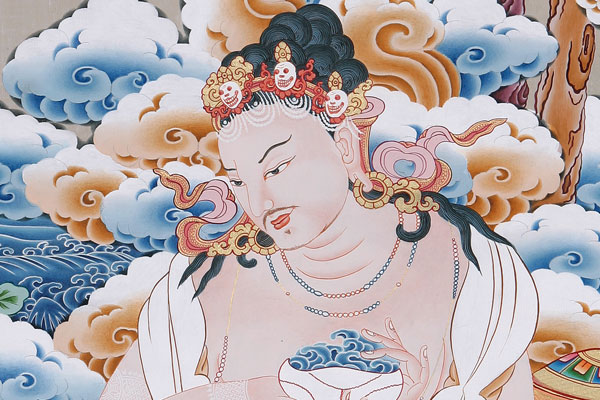Who is a true Shishya or Disciple? He is a person who upholds his guru and teaching at all times and follows no matter what the teacher says at all times. Naropa was one such disciple who dedicated his life for his Guru Tilopa and went on to become a Mahasiddhi.
By Prathima.G.Kulkarni
Naropa was born to a family of royals during 1016 AD and was destined to take his father’s place as a ruler. His original name was Samantabhadra. He was being trained to be a ruler but Naropa rebelled his trainings, as he wanted to have an intellectual education and wanted to go to Kashmir to fulfill his dream at the age of 8. Three years later, he undertook the study of Logic, Science, Grammar, Rhetoric and Arts.
His parents wanted him to marry and found him a Brahmin girl named Vimaladipi. They got married and were leading a happy life. But, Naropa’s passion to study religion and lead a spiritual life in a monastic environment was getting strong. This led for their marriage to dissolve and Naropa left to Kashmir so that he could continue his study and to become Monk.
At the age of 28, the interest that he had towards learning led him to Nalanda University near Pullahari as it was famous for its Buddhist philosophers. Naropa became one of the scholars of the university in due time. One day when he was studying under a banyan tree an old woman appeared in front of him and asked him whether he understood what he was studying? To this, Naropa answered “Yes, of course I Understand” thinking she was just an illiterate who had come to irritate him. The answer prompted her to laugh and she asked him if he experienced the meaning of the words that he was studying? Again, the answer was “Yes. I do”. This time the old woman started to cry.
Naropa asked her “Why do you cry”? The old woman started to give her explanation as such: “When you said you comprehended the words you read, I was overjoyed and when you said you understand the meaning of the words I cried because as you have not experienced Enlightenment, it is really hard for you to understand the actual meaning. Being a scholar you have mistaken that intellectual knowledge is equivalentto experiencing genuine enlightenment”. Naropa agreed that the woman was actually correct.
As the legend has it, the old lady was actually a dakiniin disguise. A ḍākinī is a type of sacred female spirit that finds mention in Vajrayana Buddhism. She told Naropa that he needs to meet her brother Tilopa if he wanted to realize enlightenment as he could guide Naropa on the path of direct mystical experience. So, Naropa went in search of Tilopa to learn from him. He had to go through twelve painful trials to experience the mystical teachings to the “Way of the Yogi” from Tilopa. Every trial that Naropa went through showed certain aspects of teaching and also broke his pride. Still Naropa did not give up and kept trying. These trials clearedNaropa’s misconceptions and increased his understanding of the universe, which ultimately led to the state of Varjradhara and Perfect Enlightenment.
When Naropa received enlightenment, he was offered the Six Bone Ornaments by Dakinis. Today, these ornaments are one of the most revered relics of Buddhism and historic symbols of a great Himalayan odyssey. Later, Naropa started to teach showing the traditional way of achieving experiential wisdom. His teachings included the Six Yogas that consisted ofmilam(dream yoga), tummo (the yoga of inner heat), bardo (the yoga of the intermediate stage), gyulu (the yoga ofillusory body), osel (the yoga of clear light), and phowa (the yoga of transference of consciousness).








